Sunday, May 15, 2011
FFTA
As a way of (deluding myself into thinking that I'm) practicing Japanese, I picked up a couple of Japanese-language video games. One I just started (Referenced above) begins with a forty-minute (at least) narrative sequence. According to wikipedia, the designers of this game were not drug into the streets and beaten to death upon its release. The only possible conclusion is that Wikipedia is, just as has been said for so long, an unreliable resource.
Saturday, May 14, 2011
Photo Roundup: May 2011
A few highlights from the past few weeks:

Melt Banana today, 5/14
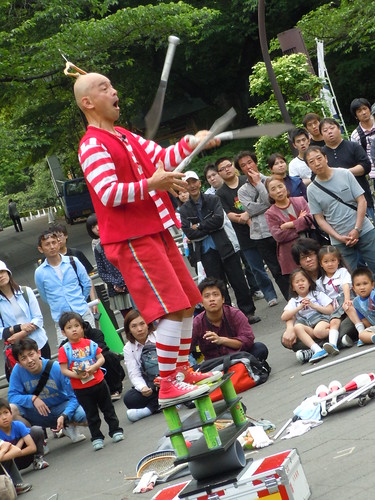
A really stunning juggler in Ueno park
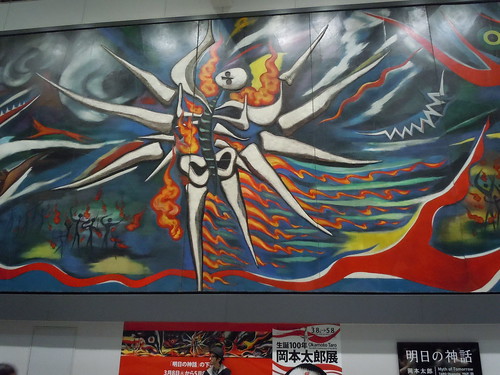
A famous mural by Okamoto Taro in Shibuya Station. Apparently the central figure is the inspiration for the apocalyptic robots of the Evangelion cartoons.
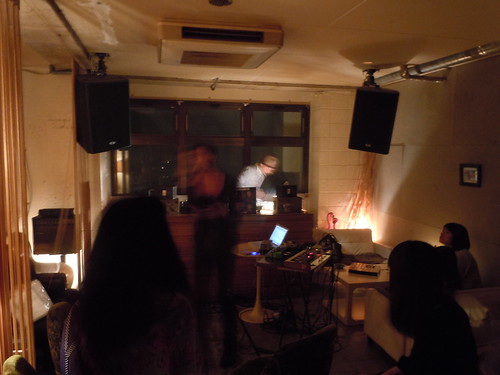
Slovenia's most popular rapper, at a small bar in Koenji called One.
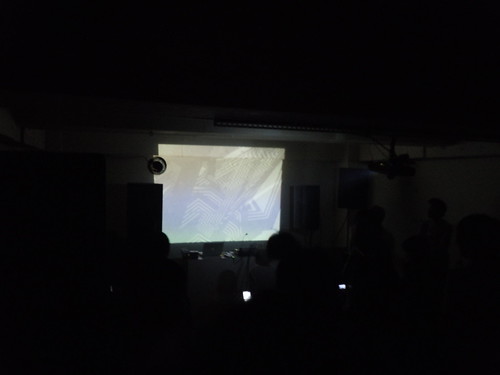
Noise and generative video at Soup, Koenji.

Melt Banana today, 5/14

A really stunning juggler in Ueno park

A famous mural by Okamoto Taro in Shibuya Station. Apparently the central figure is the inspiration for the apocalyptic robots of the Evangelion cartoons.

Slovenia's most popular rapper, at a small bar in Koenji called One.

Noise and generative video at Soup, Koenji.
Labels:
japan,
music,
music life,
noise,
photos,
underground
Thursday, May 12, 2011
BRK(L)N Connections: Hip Hop and Noise and Music and Technology
Tomorrow from about 7:30 at the fantastic club Superdeluxe, the leftfield rapper Killer Bong teams up with Japanoise stalwart Hair Stylistics – Masaya Nakahara, formerly known as Violent Onsen Geisha – to do . . . something. I’m not sure what. But apparently K-Bong does it pretty frequently, and has performed in the past with a lot of other noise artists. There’s a three-way collaboration coming up in July between Bong, DJ Baku, and Merzbow (more info as it comes my way).
The connection between hip hop and noise is also being mined across the Pacific, where the single hottest rap crew of the moment, OFWGKTA, made a big portion of its bones in affiliation with the underground psych blogosphere, sites like Gorilla Vs. Bear that mainly traffic in spacey drone-pop and the softer-edged, lo-fi, Occidental version of ‘noise.’ Another current example is the group Shabbazz Palaces, who make rap that’s stretchy and dubbed-out enough to sit comfortably next to neo-hippies like Peaking Lights and Grouper.
But this is deeper than any of-the-moment trend. Hip hop and experimental music have been worshipping at each other’s altar since the early eighties, a source traceable backwards not just in the self-conscious path through DALEK, Cannibal Ox, cLOUDDEAD, Kid 606, Dr. Octagon, Maquinquaye, and Bill Laswell* (*figuring out why exactly he’s terrible deserves a separate post), but all over the pop charts and the hearts of the dismissed “old school.”
Here’s Rammellzee’s epic “Exterior Street” (1985)
Yin-Yang Twins "Salt Shaker" (2003), which still basically sounds like Can. I could also have linked J-Kwon’s “Tipsy” (2007), the stupidest extremely weird song I can think of.
And Lil B’s “Motivation” (2011), with Clams Casino mining psych to give us one of the greatest tracks of all time.
Why do these aliens keep surfacing in a genre that we tend to believe we’ve tamed? More than some weird micro-trend that’s kept alive by willful eccentrics, this is the inevitable return of the repressed – hip hop may have gone pop, but at its root are the same forces that have been explored more self-consciously by “art music” in both its conservatory and basement forms. Hip hop is a product of technology as much as of music – its lineage stretches to the turntable and sampler no less than to James Brown and Lee Perry (and there’s no Lee Perry without the reel-to-reel, a.k.a. the turntable before the turntable).
While Morton Subotnick, Robert Moog, and various inventors and entrepreneurs were pushing the boundaries of audio technology, the beatmatchers and backscrathers of the Bronx were encountering and harnessing the potentials that had already been released into the world – new forms of recording, playback, amplification, and (later) sampling and synthesis. But they weren’t just going with the flow – they were breaking things, overloading them, detourning them: the “scratch” is a more radical analog to John Cage’s prepared piano (more radical because it entirely reconceived the purpose of the turntable, though this was itself a repeat of another of Cage’s accomplishments). Add to that the fact that while rapping did derive partly from Jamaican toasting, which derived, along with reggae, from American soul and R&B (and thus has at least a link with rock and roll), another major source was the patter of DJs on southern black radio stations – here again another cultural innovation driven powerfully by technology (for more on this, including some amazing transcriptions of proto-rap from the 1950s, see Roni Sarig’s Third Coast).
There's something here about the relationship between the avante-garde and the everyday. Did experimentalists like Luc Ferrari somehow prepare the way for hip hop? There are, of course, a few direct connections, particularly how much the Bronx loved Kraftwerk. And never underestimate the determination of a music nerd to self-educate, even if they're mired in abject poverty. But I've never read any indication that people like Herc were consciously aware of those developments. The more plausible, and coincidentally much more interesting hypothesis would be that hip hop and noise are parallel outgrowths of our media and technological environment, though certainly inflected by cultural differences. The consequence is that whenever hip hop gets truly self-reflective, it has a strong tendency to turn into noise and go underground. Just about as often, the pop impulse in hip hop forms a channel for the welling up of strange machine artifacts into the mainstream of American life.
The connection between hip hop and noise is also being mined across the Pacific, where the single hottest rap crew of the moment, OFWGKTA, made a big portion of its bones in affiliation with the underground psych blogosphere, sites like Gorilla Vs. Bear that mainly traffic in spacey drone-pop and the softer-edged, lo-fi, Occidental version of ‘noise.’ Another current example is the group Shabbazz Palaces, who make rap that’s stretchy and dubbed-out enough to sit comfortably next to neo-hippies like Peaking Lights and Grouper.
But this is deeper than any of-the-moment trend. Hip hop and experimental music have been worshipping at each other’s altar since the early eighties, a source traceable backwards not just in the self-conscious path through DALEK, Cannibal Ox, cLOUDDEAD, Kid 606, Dr. Octagon, Maquinquaye, and Bill Laswell* (*figuring out why exactly he’s terrible deserves a separate post), but all over the pop charts and the hearts of the dismissed “old school.”
Here’s Rammellzee’s epic “Exterior Street” (1985)
Yin-Yang Twins "Salt Shaker" (2003), which still basically sounds like Can. I could also have linked J-Kwon’s “Tipsy” (2007), the stupidest extremely weird song I can think of.
And Lil B’s “Motivation” (2011), with Clams Casino mining psych to give us one of the greatest tracks of all time.
Why do these aliens keep surfacing in a genre that we tend to believe we’ve tamed? More than some weird micro-trend that’s kept alive by willful eccentrics, this is the inevitable return of the repressed – hip hop may have gone pop, but at its root are the same forces that have been explored more self-consciously by “art music” in both its conservatory and basement forms. Hip hop is a product of technology as much as of music – its lineage stretches to the turntable and sampler no less than to James Brown and Lee Perry (and there’s no Lee Perry without the reel-to-reel, a.k.a. the turntable before the turntable).
While Morton Subotnick, Robert Moog, and various inventors and entrepreneurs were pushing the boundaries of audio technology, the beatmatchers and backscrathers of the Bronx were encountering and harnessing the potentials that had already been released into the world – new forms of recording, playback, amplification, and (later) sampling and synthesis. But they weren’t just going with the flow – they were breaking things, overloading them, detourning them: the “scratch” is a more radical analog to John Cage’s prepared piano (more radical because it entirely reconceived the purpose of the turntable, though this was itself a repeat of another of Cage’s accomplishments). Add to that the fact that while rapping did derive partly from Jamaican toasting, which derived, along with reggae, from American soul and R&B (and thus has at least a link with rock and roll), another major source was the patter of DJs on southern black radio stations – here again another cultural innovation driven powerfully by technology (for more on this, including some amazing transcriptions of proto-rap from the 1950s, see Roni Sarig’s Third Coast).
There's something here about the relationship between the avante-garde and the everyday. Did experimentalists like Luc Ferrari somehow prepare the way for hip hop? There are, of course, a few direct connections, particularly how much the Bronx loved Kraftwerk. And never underestimate the determination of a music nerd to self-educate, even if they're mired in abject poverty. But I've never read any indication that people like Herc were consciously aware of those developments. The more plausible, and coincidentally much more interesting hypothesis would be that hip hop and noise are parallel outgrowths of our media and technological environment, though certainly inflected by cultural differences. The consequence is that whenever hip hop gets truly self-reflective, it has a strong tendency to turn into noise and go underground. Just about as often, the pop impulse in hip hop forms a channel for the welling up of strange machine artifacts into the mainstream of American life.
Sunday, May 8, 2011
5.7 Anti-Nuclear Demo: A Simplistic Message Fuels a Profound Event
I've already waited too long to set down some version of my very intense experience at Saturday's anti-nuclear rally. The numbers coming back from news organizations paint it as a bit of a disappointment - partly due to rain, partly due to a major victory handed to activists by PM Kan just the day before, in the form of the ordered shutdown of a reactor in central Japan. Speaking strictly for myself, I think the core message of the demo - "No Nukes!" - is almost childishly simple, perhaps distracting from the really constructive project of promoting renewable energy, not to mention the more profound and radical possibilities for overhauling industrial capitalism (perish the thought).
All that aside, this was a transformative event. I came to it as someone who has attended a lot of marches put on by the central organizers of this demo, Shirouto no Ran. They frequently have demo/parties on May Day and generally are interested in poverty issues - but always with a slightly confrontational edge, including a profusion of absurdism and rnoisy music, which helped these marches palpably alienate passersby. This one was different.
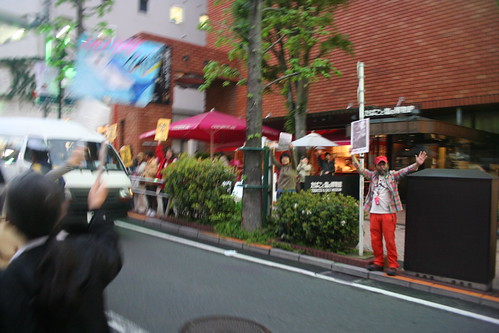
All along the route, there were both people who seem to have broken off from the march (as seen here), and those who just happened to be passing by, saw what was happening, and smiled, waved, or in some cases started cheering along. The energy was amazing.
Another great thing was how wide a spectrum of people was represented, from kids to older folks, and not just fringe or freaky people. Many of these people had never participated in this sort of demonstration before.

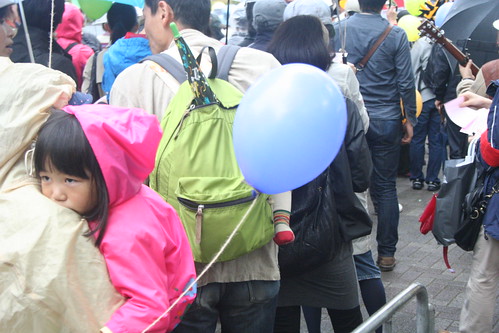
This is a huge contrast with the regular Shirouto no Ran demo, which is made up largely of punk rockers, dadaists, and other weirdos (not that there weren't some of those here).
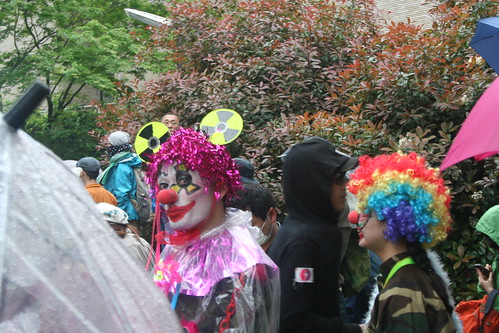
I suddenly found myself with a new appreciation for all those slightly alienated May Day marches, whose effectiveness I've always been pretty skeptical of. They were dress rehearsals for this - an issue powerful enough to draw in people, who just need experienced organizers to give them an outlet for their anxiety and anger.
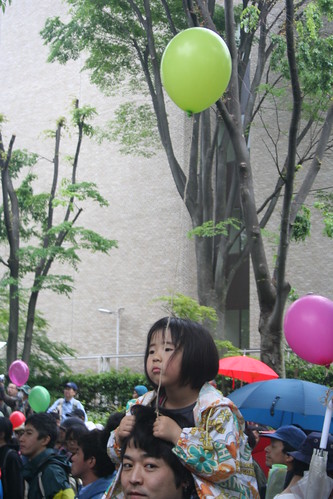
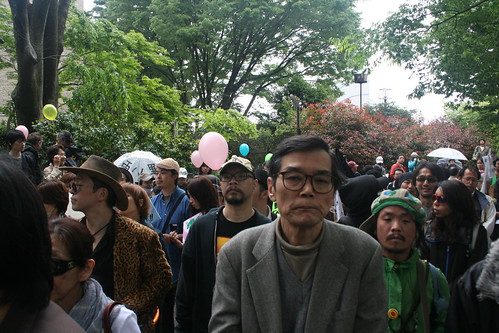
All that aside, this was a transformative event. I came to it as someone who has attended a lot of marches put on by the central organizers of this demo, Shirouto no Ran. They frequently have demo/parties on May Day and generally are interested in poverty issues - but always with a slightly confrontational edge, including a profusion of absurdism and rnoisy music, which helped these marches palpably alienate passersby. This one was different.

All along the route, there were both people who seem to have broken off from the march (as seen here), and those who just happened to be passing by, saw what was happening, and smiled, waved, or in some cases started cheering along. The energy was amazing.
Another great thing was how wide a spectrum of people was represented, from kids to older folks, and not just fringe or freaky people. Many of these people had never participated in this sort of demonstration before.


This is a huge contrast with the regular Shirouto no Ran demo, which is made up largely of punk rockers, dadaists, and other weirdos (not that there weren't some of those here).

I suddenly found myself with a new appreciation for all those slightly alienated May Day marches, whose effectiveness I've always been pretty skeptical of. They were dress rehearsals for this - an issue powerful enough to draw in people, who just need experienced organizers to give them an outlet for their anxiety and anger.


Tiny Steps
A common sight on the streets of Tokyo is a man, perhaps in his late seventies, shuffling along the sidewalk, taking steps of no more than three or four centimeters at a time, carefully supporting himself first by a bit of wall, then a pole, then a guardrail. They move with an almost unreal slowness as everyone else on the sidewalk streams around them.
Another common sight is women, also in their late seventies or early eighties, bent nearly double by osteoporosis and hanging onto a walker or grocery cart as if to a chariot speeding out of control as they slowly totter down the street.
These are people old enough to have suffered two abuses. Their health can't have been helped by childhoods lived during the postwar years of near-starvation. And their society has changed beneath their feet from one in which social standards still provided some protection for the elderly (if not the more elusive respect that Orientalism imagines) to one seeking to replace familial trust with indequate state support.
Another common sight is women, also in their late seventies or early eighties, bent nearly double by osteoporosis and hanging onto a walker or grocery cart as if to a chariot speeding out of control as they slowly totter down the street.
These are people old enough to have suffered two abuses. Their health can't have been helped by childhoods lived during the postwar years of near-starvation. And their society has changed beneath their feet from one in which social standards still provided some protection for the elderly (if not the more elusive respect that Orientalism imagines) to one seeking to replace familial trust with indequate state support.
Sunday, May 1, 2011
David Schmidtz - Motivation and Tips for Writing
There are dozens of great pieces of advice here. Watch it repeatedly. Or if you're as venal as me, skip straight to part two, where Schmidtz does some stunning math - writing enough can net you hundreds of thousands of dollars a year in additional salary.
Subscribe to:
Posts (Atom)